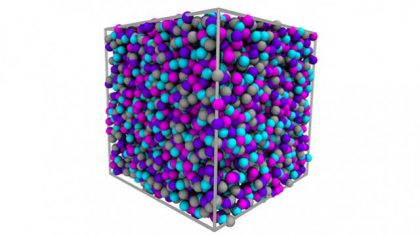
Not everything about glass is clear. How its atoms are arranged and behave, in particular, is startlingly opaque. The new studies on glass physics show that it is possible to make it more clear. PIMI believes that due to some relevant amorphous structure of glass and amorphous polymers, this new sturdy might be interesting for those active in polymer industry. This the reason for re-publishing of part of the main article for your knowledge of the day.
Based on a news that Northwestern University published, The problem is that glass is an amorphous solid, a class of materials that lies in the mysterious realm between solid and liquid. Glassy materials also include polymers, or commonly used plastics. While it might appear to be stable and static, glass’ atoms are constantly shuffling in a frustratingly futile search for equilibrium. This shifty behavior has made the physics of glass nearly impossible for researchers to pin down.
Now a multi-institutional team including Northwestern University, North Dakota State University and the National Institute of Standards and Technology (NIST) has designed an algorithm with the goal of giving polymeric glasses a little more clarity. The algorithm makes it possible for researchers to create coarse-grained models to design materials with dynamic properties and predict their continually changing behaviors. Called the “energy renormalization algorithm,” it is the first to accurately predict glass’ mechanical behavior at different temperatures and could result in the fast discovery of new materials, designed with optimal properties.
 “The current process of materials discovery can take decades,” said Northwestern’s Sinan Keten, who co-led the research. “Our approach scales molecular simulations up by roughly a thousand times, so we can design materials faster and examine their behavior.”
“The current process of materials discovery can take decades,” said Northwestern’s Sinan Keten, who co-led the research. “Our approach scales molecular simulations up by roughly a thousand times, so we can design materials faster and examine their behavior.”
“Although glassy materials are all around us, scientists still struggle to understand their properties, such as their fluidity and diffusion as temperature or composition vary,” said Jack F. Douglas, a NIST research fellow, who co-led the work with Keten. “This lack of understanding is a serious limitation in the rational design of new materials.”
Glass’ strange behavior stems from the way it is made. It starts as a hot pool of molten material that is then rapidly cooled. Although the final material wants to reach equilibrium in a cooled state, it is highly susceptible to changing temperatures. If the material is heated, its mechanical properties can change dramatically. This makes it difficult for researchers to efficiently predict the mechanical properties by using existing molecular simulation techniques.
Fore more information please read: Source
************************
Why Should Be “A Paid-Subscriber” and “Advertiser”
Keeping an independent media in countries that impose limitations on self supporting media, will help to support the humankind’s freedom. If you believe it, please act to be a PRO-MEMBER by clicking “HERE“, or:
Please send your PR’s directly to the email address of the Chief-Editor in order to be published at once in the world via ” http://pimi.ir ” The address is: aasaatnia@live.com.
Why Should Be “A Paid-Subscriber”?
Keeping an independent media in countries that impose limitations on self supporting media, will help to support the humankind’s freedom. If you believe it, please act to be a PRO-MEMBER by clicking “HERE“














